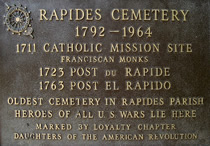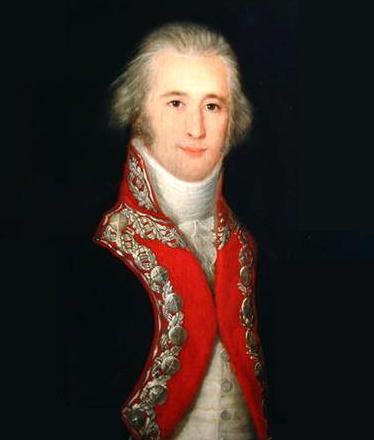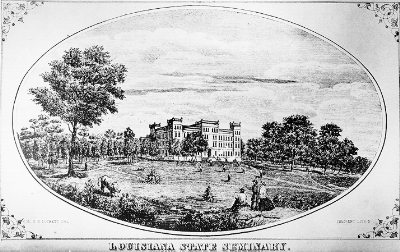| Historians do not completely agree about the earliest date a settlement of any kind was established on the site of what we now call the City of Pineville. One claimed that in 1711 “a mission chapel was built at Pineville, in what is now called Rapides Cemetery.” Another used 1723 as the date when soldiers were stationed at a post built to overlook the lower rapids. |
 |
The earliest records indicate that around 1711, Pineville was an outpost and trading village for early settlers. It is not known how much earlier than that a settlement existed. Pineville owes its origin to the Red River. The name Rapides is a form of the early designation given to the district and county. It is derived from the fact that in the early 18th century, a lack of water in the Red River during certain seasons of the year formed rapids just above the present city of Pineville.
The rapids began at a location on the river just north of the former site of Fort Buhlow that ended near the south end of the former site of Fort Randolph. This location became known as El Rapido, “The Rapids” in Spanish. To the north of El Rapido lived the Caddo and the Avoyel Indians and to the south were the Attakapa and Appalacha Indians.
The rapids presented a serious impediment to all river navigation, even the smallest crafts, for nearly half of the year. In the early 18th century, it was alleged that Indians would station themselves along the river bank and lie in wait until a party reached that point on the river. As the party portaged the rapids, the Indians would attack and plunder what they could. Hoping to find a way to stop the Indians from attacking the travelers, the French Inspector General of the Providence of Louisiana, Diron d'Artaguette, established a military post north of the rapids along the Red River. In 1723, Post Du Rapides was established on the site of where the Rapides Cemetery is located today.
On an inspection trip up the Red River in May 1722, d'Artaguette advocated in his report that a post be established at “the place called The Great Rapid which is a point almost halfway between the beginning of Red River and Natchitoches and where the river ceases to be navigable four to five months of the year.”
The French controlled Louisiana from its first settlements in the late 17th century until the Treaty of Paris was signed in 1763, signaling the end of fighting between the English and French. At the same time Spanish and French negotiators signed the Treaty of San Ildefonso, which confirmed the cession of French Louisiana to Spain, ending the French threat of invasion upon British colonists along their frontier territory. As a result of the Treaty of Paris, all land east of the Mississippi River was transferred to England and white men began to pour into the territory, forcing the Indians to retreat.
 |
In 1769, Alejandro O’Reilly was appointed Governor and Captain-General of Louisiana to put down a French rebellion. He reorganized the colony and emphasized fairness to anxious French colonists uneasy about Spanish rule. O’Reilly sent commissioners throughout the territory to report and take a census. In 1770, the census shows that the Post du Rapides had a population of 33 whites, 18 slaves, and a small village of Indians. |
In 1800, Napoleon Bonaparte forced Spain to secretly return the Louisiana Territory back to France in the Third Treaty of San Ildefonso. When this news reached President Thomas Jefferson, and fearing the establishment of a second French empire in the America’s that would halt western expansionism of the United States, Jefferson offered to buy the territory to establish a port at New Orleans. Needing the funds to support his Napoleonic Wars, Bonaparte sold the land in 1803, to the United States for $15M (less than four cents per acre) in what would be known as the Louisiana Purchase. On April 30, 1812, Louisiana became the eighteenth state.
By the mid-1800s, this area became known as Pineville because of the large number of beautiful virgin pine trees on the rolling hills overlooking the Red River and had been a very important location along the river. In 1860, a visitor J.W. Dorr, wrote that in “Pineville dwell a large number of citizens whose occupation is in Alexandria.” Many preferred living in Pineville because of its higher elevation and healthier climate.
 |
In March of 1860, the Louisiana Seminary of Learning and Military Academy opened about 3-miles north of Pineville, with five professors and 19 cadets. Its first President, William Tecumseh Sherman, is said to have often walked into town. Due to the American Civil War, much of the school’s facilities were destroyed. However, the main school building was saved by request of Union General W.T. Sherman. After the war, the seminary reopened in April 1865. Unfortunately, the college’s main building was lost in a fire on October 15, 1869 and on November 1, 1869, classes resumed in Baton Rouge. In March 1870, the school’s name was changed to The Louisiana State University. |
| In 1864, as union troops retreated back down the river during the Red River Campaign, they found their gun boats trapped above the rapids. Union officer, Lt Joseph Bailey engineered a make shift dam (Bailey's Dam) at a point below the site of what would be Fort Buhlow, which allowed the boats to pass over the great boulders. Following the campaign and for fear of a Union return, Fort Buhlow and Fort Randolph were built as earthworks on the bluffs above the rapids as Confederate defenses. |
 |

On March 4, 1878 Pineville was granted a charter of corporation by the state of Louisiana.






